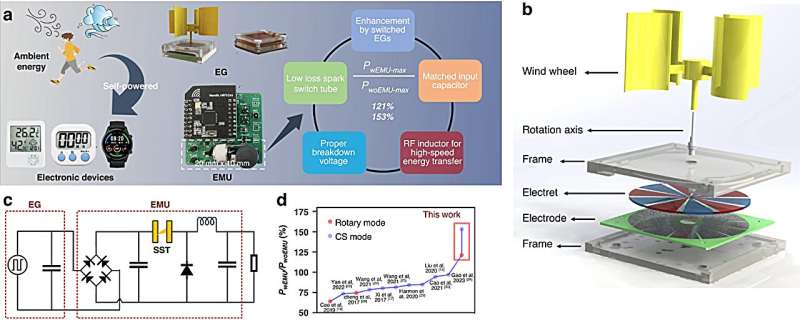This article has been reviewed according to Science X's editorial process and policies. Editors have highlighted the following attributes while ensuring the content's credibility:
fact-checked
peer-reviewed publication
trusted source
proofread
Powering the future: Advanced energy harvesting for loT devices

Researchers have developed a high-performance energy management unit (EMU) that significantly boosts the efficiency of electrostatic generators for Internet of Things (IoT) applications. This breakthrough addresses the challenge of high impedance mismatch between electrostatic generators and electronic devices, unlocking new possibilities for ambient energy harvesting.
Electrostatic generators have emerged as a promising solution for powering low-power devices in Internet of Things (IoT) networks, utilizing energy from environmental sources such as wind and human motion. Despite their potential, the effectiveness of these generators has been hampered by an impedance mismatch when connected to electronic devices, leading to low energy utilization efficiency.
A study published in the journal Microsystems & Nanoengineering introduces an efficient energy management unit (EMU) designed to significantly boost the power efficiency of electrostatic generators for IoT devices. This innovation addresses the longstanding challenge of impedance mismatch and propels forward the potential for using environmental energy harvesting within the IoT domain.
The research team has significantly enhanced the power efficiency of electrostatic generators by implementing an innovative EMU equipped with a spark-switch tube and buck converter. This breakthrough led to an unprecedented direct current output of 79.2 mW m-2 rps-1 in rotary electret generators, marking a significant leap in efficiency. Furthermore, the EMU increased the performance of contact-separated triboelectric nanogenerators by 50%, demonstrating its versatility across different energy-harvesting technologies.
This advancement stems from the meticulous optimization of critical components, such as the spark-switch tube and buck converter, which propelled direct current power generation to new heights. This progress not only surpasses existing energy efficiency benchmarks but also underscores the EMU's compatibility with a wide array of generator designs.
Zeyuan Cao, co-author of the study, states, "Our work represents a significant step towards the practical application of electrostatic generators in IoT devices. By optimizing our EMU, we've achieved unprecedented efficiency, making self-powered IoT devices more viable than ever."
This breakthrough not only enhances the efficiency and reliability of self-powered IoT devices but also facilitates their broader adoption in sustainable and remote applications. It heralds a new era of energy autonomy within the IoT landscape, marking a significant advancement in the realm of environmental energy harvesting for IoT applications.
More information: Zibo Wu et al, Electrostatic generator enhancements for powering IoT nodes via efficient energy management, Microsystems & Nanoengineering (2024). DOI: 10.1038/s41378-024-00660-1


















